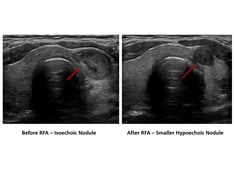A study in animals suggests hope may be on the horizon for a novel agent to treat hyperparathyroidism. Mice that were deficient in semaphorin3d (Sema3d), a secreted protein, developed an abnormally large parathyroid gland, but inhibiting a signaling pathway involved in this process partially "rescued" them, in a new study.
The finding suggests that an effective, safe recombinant protein drug that targets the signaling pathway could be developed to treat patients with hyperparathyroidism.
And if further research finds that this molecule can shrink mouse parathyroid tumors, it might also be developed as a drug to treat parathyroid cancer, the researchers add.
The study by Anamika Singh, PhD, Duke-NUS Medical School, Singapore, and colleagues was recently published in the Journal of Biological Chemistry.
"We propose," the group writes, "that since Sema3d is a secreted protein, it may be possible to use recombinant Sema3d or derived peptides to inhibit parathyroid cell proliferation causing hyperplasia and hyperparathyroidism."
This "discovery is a potential game changer in the [future] treatment of hyperparathyroidism," Patrick J. Casey, PhD, senior vice dean of research at Duke-NUS Medical School, who was not involved in the research, said in a statement by his institution.
According to Casey, "considering [that hyperparathyroidism] is common in the elderly [especially postmenopausal women], possible drug-based therapeutic options in the future would reduce the burden of surgery and associated risks in these...patients."
The most common treatment for hyperparathyroidism, when indicated, is surgical removal of the parathyroid gland, which provides a cure in most cases, but reoperation is often needed, and this "remains technically challenging," added senior author Manvendra K. Singh, PhD, Duke-NUS Medical School.
"Not many molecules are known to inhibit parathyroid growth," he added, "and there are no drugs available on the market" that specifically do this.
An Important and Exciting New Area of Research
The current study findings suggest "a novel mechanism for potential therapeutic biologics to be developed for individuals with primary, secondary, or tertiary hyperparathyroidism, and potentially for patients with the rare case of parathyroid cancer," Angela M. Leung, MD, David Geffen School of Medicine at UCLA, Los Angeles, California, who was not involved in the study, commented to Medscape Medical News.
Some patients who need treatment for hyperparathyroidism, especially primary hyperparathyroidism, "may not be good surgical candidates or not desire parathyroid surgery, or the disease may be persistent or recurrent despite surgical intervention or treatment with the currently available therapeutic options," Leung added.
"In such individuals, the potential availability of another agent that is based on an entirely different mechanism of action represents an important and exciting new area of treatment," she emphasized.
Primary Hyperparathyroidism Relatively Common
The parathyroid gland maintains calcium homeostasis, Singh and colleagues explain in their article.
Primary hyperparathyroidism — where the parathyroid gland secretes too much parathyroid hormone (PTH) — is a relatively common endocrine disorder, which affects 0.1% to 1.0% of the general population and up to 2.1% of postmenopausal women, they add.
Other patients have secondary hyperparathyroidism mainly caused by chronic kidney disease.
In either type of hyperparathyroidism, serum PTH levels are increased, which increases serum calcium, and which can lead to kidney stones, neuropsychiatric disorders, and osteoporosis.
Clinicians may use watchful waiting, or if indicated, surgery (parathyroidectomy).
Or patients may be given a calcimimetic such as cinacalcet (Sensipar, Amgen), which is approved by the US Food and Drug Administration (FDA) for the treatment of secondary hyperparathyroidism in adults with chronic kidney disease who are on dialysis, hypercalcemia in patients with parathyroid cancer, and severe hypercalcemia in patients with primary hyperparathyroidism who cannot undergo parathyroidectomy.
And in 2017, the FDA approved the novel calcimimetic etelcalcetide (Parsabiv, Amgen) to treat secondary hyperparathyroidism in adults on hemodialysis.
Target the Sema3d–EGFR/ErbB Axis
Singh and colleagues aimed to see how expression of Sema3d is related to the development of the parathyroid gland. They showed that Sema3-deficient mice develop primary hyperparathyroidism and Sema3d inhibits parathyroid cell proliferation.
Moreover, "molecular and biochemical analyses suggest that Sema3d inhibits parathyroid cell proliferation by decreasing the epidermal growth factor receptor (EGFR)/Erb-B2 receptor tyrosine kinase signaling pathway," they explain.
This suggests that the "Sema3d–EGFR/ErbB signaling axis may be targeted to treat parathyroid hyperplasia, especially in persistent or recurrent hyperparathyroidism after parathyroidectomy," they conclude.
Future Antiparathyroid Tumor Strategy?
The research might also lead to a new drug for parathyroid cancer.
"A recent study by Casazza et al [Arterioscler Thromb Vasc Biol. 2011;31:741-749] demonstrated that systemic and targeted delivery of Sema3A inhibits tumor progression in multiple mouse models," Singh and coauthors note, although "the inhibitory effect of systemic or targeted Sema3d delivery on parathyroid tumor progression remains to be investigated."
The current study findings "may also be relevant to other tumor types," such as high-grade gliomas (glioblastoma), they add.
"However, the signaling pathways mediating these effects of [Sema3d] in gliomas have not been identified."
"Thus, future work in this direction is required for the development of...anti-tumor therapeutic strategies targeting the semaphorin signaling pathway."
The study was supported by Duke-NUS Medical School Singapore, the Goh Foundation, and a Singapore National Research Foundation fellowship. The researchers have reported no relevant financial relationships. Leung is on the advisory board for Medscape Diabetes & Endocrinology.
J Biol Chem. 2019;294:8336-8347. Abstract
For more diabetes and endocrinology news, follow us on Twitter and on Facebook.
Medscape Medical News © 2019
Cite this: Discovery Could Herald 'Game Changer' for Hyperparathyroidism - Medscape - Jun 07, 2019.












Comments